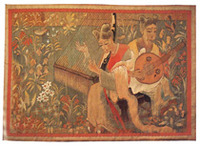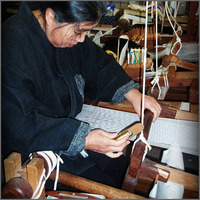

Total:131items
- Pottery & Porcelain (18)
- Lacquerware (4)
- Glasswork (2)
- Wood & Bamboo Work (19)
- Leather Work (1)
- Papermaking (13)
- Textile (20)
- Touzan-Ori: Touzan Weaving
- Sakai Gogatsu Koinobori: Sakai May Carp Streamer
- Nanbu Sakiori
- Nihon Shishu: Japanese Embroidery
- Tsuzurenishiki-Ori: Tsuzurenishiki Weaving
- Ojiya-Tsumugi: Ojiya Pongee
- Ise-Momen: Ise Cotton
- Ojiya-chijimi: Ojiya Crepe
- Yanai-jima: Yanai Stripes
- Kogin-zashi: Kogin embroidery
- Tamba Momen: Tamba Cotton
- Awa Shijira-ori: Awa Shijira Weaving
- Saga Nishiki: Saga Brocade
- Shinshu-Tsumugi: Shinshu-Pongee
- Kyo-nui: Kyoto Embroidery
- Noto Jofu: Noto-jofu hemp fabric
- Matsusaka Momen: Matsusaka Cotton
- Murayama Oshima Tsumugi
- Nibutani-attus
- Oku-Aizu Showa Karamushi Ori: Oku-Aizu Showa Ramie Textiles
- Dyeing products (5)
- Masonry (1)
- Metal Work (11)
- Stationery (4)
- Livingware (3)
- Accessory (4)
- Toys & Entertainment (14)
- Interior (2)
- Other crafts (10)

 |
Main Production Site:Chiba |
 《Characteristics》
《Characteristics》Tsuzurenishiki-ori is also called Tsuzureori. It originated in West Asia, and it was discovered from the tomb of the Egyptian kings and Altai. Later, it spread east and west. It is used in many parts of the world, such as Copts (Egypt), tapestry (France) and gobelins (France), which were the most primitive plain weave fabric.
[A Designated Traditional Craft by Chiba Prefecture]
Source and Data provided by Tsuruokatsuzure Kyoraian
Translation by: Yoko Hokari, reviewed by Chan Yitin

| Materials | Dyed silk threads |
|---|---|
| Crafting Processes | Both plain parts and patterned parts are plain weave. The difference between Tsuzurenishiki Weaving and general figured fabric is that it does not pass weft thread by all over the width except plain parts. Because weft thread of plain parts and patterned parts are separately woven, to fold the boundary line of adjacent two-colored weft thread side to side along the boundary line, a gap is generated along the weft thread. It is called “hole of Hatsuri”.
It does not use reed same as general textile. Dyed silk threads are used as warp thread. While watching the conversed pattern sketch placed under the warp thread, weft thread is inserted obliquely toward warp thread by shuttle. The pattern is raked up by the sawtooth-like middle finger nail with the fine-tooth comb. Because the works is rolled with weaving, hand weavers can see only the parts working in progress as a slit. Therefore, when creating large works, they draw two rough sketches. One is laid under warp thread. The other one is put on the wall for confirmation of whole image. When weaving intricate pattern, which more complicated fingers skills are needed, for a thirty centimeter-width textile, they can proceed only a few centimeters a day. It is daunting task which needs a good deal of time and effort. |
| History | Tsuzurenishiki-ori is brought to Japan from China during Nara period (8c), and silk thread was used. National treasure, ‘Tuzureori Taima Mandarazu’, which passed down to Taimadera in Nara prefecture is also during that time.
After that, although it had been abandoned, it revived at the end of Edo era (19c). During Meiji era (19-20c), even art works were seen and it was exported overseas. Tsuzurenishiki-ori is recognized as one of the best quality textiles same as Goblin tapestry. It is produced as fine arts and crafts, such as crepe wrapper, drop curtain, wall hanging and sash. |
| Related URL | http://kyoraian.com/ |
◆Exhibition / Showcase
[Tsuzure-Weaving Class]
Venue:
Kyoraian Kobo (Kyoraian Workshop)
51, Machinouchi, Maruoka, Tsuruoka City, Yamagata Prefecture
(Within the property of Tentakuji Temple)
Day & Time:
10:00 am - 3:00 pm on Wednesday, Thursday, Friday, and Saturday
(With lunch break)
Fee:
3,000 yen (Including the cost of materials and weaving machine)
[Hand Spun Yarn Weaving Workshop]
Venue:
Kyoraian Kobo (Kyoraian Workshop)
51, Machinouchi, Maruoka, Tsuruoka City, Yamagata Prefecture
(Within the property of Tentakuji Temple)
Fee:
- Coaster size (9.5-10cm) 1,200 yen
(Including the cost of materials and weaving machine)
Duration: 1 h
- Table center size (15-18cm) 2,000 yen
(Including the cost of materials and weaving machine)
Duration: 2 h
Reservations and inquiries (Japanese only)
Assistance needed? For inquiries in English:
JTCO Contact Form
Your inquiries will be forwarded by JTCO in Japanese to the organization you wish to contact.



